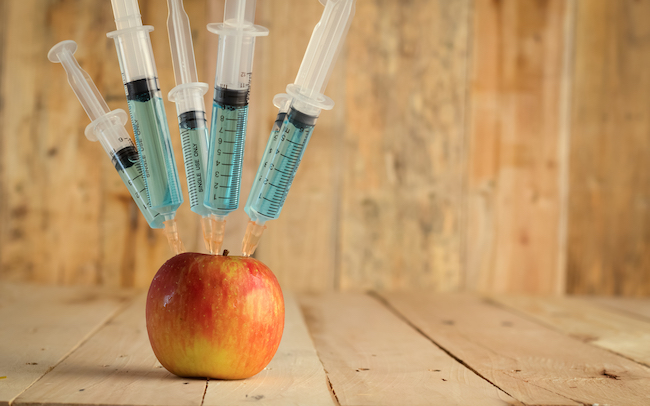
Ask anyone whether they’d like a genetically modified fruit or vegetable to be included in their dinner and you’re likely get an earful of talking points about how GMOs are unhealthy, cause cancer, and will likely suck all of us into a black hole. Then, if the person you’re speaking to — why did you even ask about GMOs in this hypothetical scenario? This is on you! — is especially passionate, they’ll pull out their cellphone to show you pictures of genetically altered white strawberries and square watermelons before demanding to know whether you care at all about what you put in your body.
The intentions are good, but there’s one thing everyone needs to know: GMOs will not end the world and some of those examples people use to prove that modifying an organism’s genetic code is very bad aren’t actually examples of GMOs at all.
In the wake of Vermont becoming the first state to require that genetically altered foods be marked as such, and right before a vote that could expand that requirement all throughout the nation, the New York Times took some time to dispel the fears that the general public has about GMOs. Of course, this might not convince the hardcore believers among us (there are some people who will never believe that square watermelons are, as the Times points out, grown in boxes as opposed to being engineered in labs), but if you’re on the fence about GMOs the piece might have some important information for you.
Perhaps we should be more concerned about the fact that people are torturing watermelons by trapping them in metal boxes than genetic modification?
Aside from the fact that understanding the new labels may be more difficult (how many of us can truly read and comprehend a nutrition label now?), there’s evidence that labeling something as “non GMO” is more of a marketing ploy than anything else. Just because a product is marked “non-GMO” for instance, doesn’t mean a version of that product ravaged by science exists.
Take steel-cut oatmeal for example:
The white and gold aluminum cans of McCann’s Steel Cut Irish Oatmeal, which is among tens of thousands of products certified in recent years by the Non-G.M.O. Project, now carry a label indicating they have no G.M.O. ingredients. But nothing has changed about the oats inside the cans. Some flavored oatmeals may have been made with genetically modified ingredients. But as seen with the proliferation of labels on fat-free or gluten-free products — like water — that never contained fat or gluten, the G.M.O.-free label does not mean a genetically engineered version of that product exists.
And that’s not all. According to the Times, there’s no real health risk to eating genetically modified food. People can believe that GMOs are responsible for many of the world’s ills, but the FDA has stated that suggesting a food that’s not been genetically modified is somehow safer or better for you than the alternative is untrue and, in fact, misleading. And there’s absolutely no evidence that genetically modified food is somehow to blame for the host of diseases and disorders — including cancer and autism — that it’s been accused of perpetuating.
In fact, genetically modified wheat (which the Times points out has been blamed for gluten insensitivity) isn’t even available for any of us to purchase:
Countless websites, blog posts and messages on Twitter blame genetically modified wheat for the increase in gluten sensitivity. The fundamental hole in this argument is that genetically modified wheat is not sold to the public.
To be clear, wheat has been genetically modified. Monsanto has field-tested wheat that was altered to tolerate the herbicide glyphosate. A British research institute field-tested modified wheat to repel insects. (It didn’t work.) In 2014, Chinese researchers modified wheat to resist a disease called powdery mildew, but just to see if they could.
Still want all that labeled? Great. Being informed is important and we’ll be scanning labels in the grocery stores with the everyone else. But it’s just as important to recognize that the labels will not tell the whole story. They’ll certainly provide you with a basic marker (so you can avoid the food if you want to), but they won’t tell you why or how your produce was modified (even if it was for a very good reason). Furthermore, not every product that was altered by scientists will have to be labeled as such. A mushroom that’s had part of its DNA “deleted,” according to the Times, won’t need to be regulated in the same way that a mushroom that’s had its DNA added to will. (Why are people messing with mushroom DNA? To keep white-button mushrooms pure as the driven snow, of course!)
You can check out the rest of the misconceptions (both good and bad) at the New York Times, where you’ll soon discover that those gigantic chickens you’re certain were made in a lab are actually products of creative crossbreeding.






